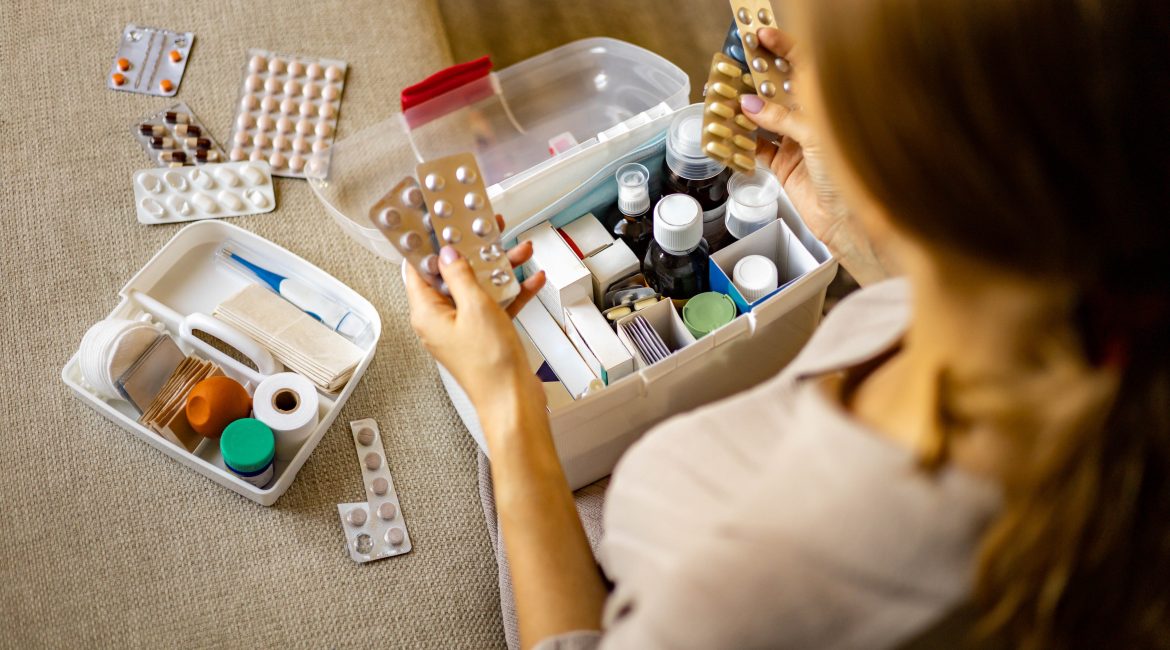Be prepared for bruises, bumps and other mishaps with these first aid kit necessities.
If your first aid kit at home consists of a few plasters (band aids), maybe some sort of antiseptic ointment and perhaps, if you’re lucky, some plastic gloves (make that one glove), then stop what you are doing and read this – because our first aid checklist could even save a life! (No, we are not kidding).
They say that home is where the heart is, but oddly enough, it is also where the hurt is. Bumps, boo boos, scrapes and scratches happen in every home and the best thing you can do is be prepared for them. All of these items in our first aid checklist can be bought from your local pharmacy. Every home should be equipped with the basics of a good first aid kit. Yes – EVERY home.
Related: 4 Common Insect Bites and Stings & How to Treat Them
That’s why we have put together this simple list of must have first aid items for your home:
Our Complete First Aid Kit Essentials List
1. Antiseptic liquid spray
Even the most minor scratches and cuts can lead to a serious infection if they are left untreated. No first aid kit is complete without a bottle of antiseptic liquid spray for those unexpected booboos.
2. Band-aids
These are probably the handiest and most used items in a first aid kit – make sure you have plenty of these in different shapes and sizes. They help in protecting wounds, blisters, rashes, insect bites and also keep some nasty infections away.
3. Antiseptic swabs and wipes
These are great for all kinds of cuts, grazes and wounds and allow for a quick fix to stop any infections from occurring.
4. Bandages
Adhesive bandages in several sizes
2 triangular elastic bandages (these are pressure bandages)
2 crepe roller bandages, 1 large and 1 small
Pressure bandages: These help in treating strained limbs in reducing swelling. For example, when spraining your wrist, you could wrap it in a pressure bandage until you see the doctor. It is also great for fractures and can be used to make a sling. A pressure bandage is basically a type of dressing that is stretchy and is placed over a wound or injury.
5. Bandage shears
Ensure that your first aid kit has a sharp pair of scissors to cut the bandage.
6. Ice pack (to be kept in your freezer)
This is something that is often left out of first aid checklists, but it can really come in handy when treating swelling or even skin reactions.
7. CPR kit
This is for when someone has stopped breathing or their heartbeat has stopped. We suggest you take a first aid course to know how to use this kit for emergency situations. This kit should contain a disposable resuscitation mask, gloves, antiseptic wipes and instructions.
Discover: What To Do If Someone Is Having a Heart Attack: 4 Steps
8. Stainless steel tweezers
These are great for so much more than just plucking your eyebrows or stray hairs. These can help remove splinters, gravel or dirt from wounds as well as glass or something similar from a wound.
9. Gloves
You need to make sure that your first aid kit ALWAYS has 2 pairs of gloves. This ensures that when you are treating wounds and other injuries that the germs from your hands do not infect the wound.
10. Emergency contact list
Make sure that your first aid kit has a piece of paper (laminate this) with all your emergency contacts. This should include the ambulance, police, doctor, close friends and family and anyone else you deem as an emergency contact.
11. Adhesive, hypoallergenic tape
Tape is great for holding a bandage in place.
12. 4 packs of sterile gauze swabs
These are places over a wound before strapping, taping or bandaging, These can also be used as a disinfectant for hard surfaces when soaked in antiseptic and used to clean counters etc. before treating an injury on the area.
13. 2 large and 2 small sterile dressings
14. 2 sterile eye dressings
15. 2 eye pads with bandages
16. 1 pack of sterile cotton wool swabs
17. Antibiotic cream
18. 1 pack of paracetamol tablets, including liquid paracetamol
19. Rehydration sachets
20. 6 safety pins
21. Face cloth
22. Thermometer
23. Torch and spare batteries
Read this: Asthma: A Simple Guide to The Disease
Bonus tip
for emergency situations make sure you are covered with health insurance! Sometimes a first aid kit just can’t cut it and you need to see a doctor, or worse, be rushed to hospital. That’s where health insurance comes in. We help in covering the costs of private healthcare and also offer day to day benefits like seeing your doctor for a check-up.
Did we mention we’re also the only health insurer that pays you BEFORE you see your doctor? Get a quote right now – it will only take one minute (yup – one minute).
Your Health Insurance Family,
Oneplan




